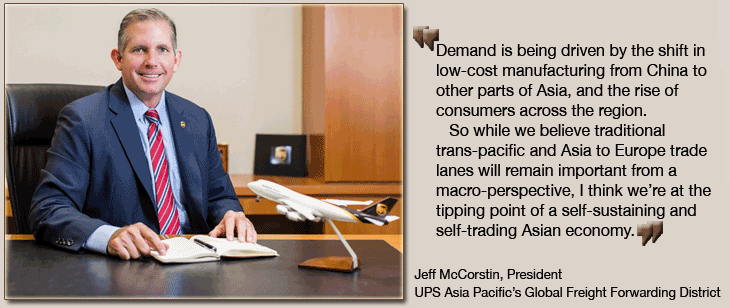
Jeff McCorstin has become one of FlyingTypers’
go-to guys for freight strategy in Asia. And, as ever, our latest conversation
with the President of UPS Asia Pacific’s Global Freight Forwarding
District was nothing short of illuminating.
He is optimistic on the short- and long-term
prospects of the air freight market, particularly on the Transpacific
trades where, over the last year, UPS has found success offering solutions
from across its product portfolio which allow clients to avoid U.S. West
Coast port congestion. He also believes that in many parts of the world
the economic outlook is improving.
“In the U.S., employment, consumer
sentiment, and business sentiment are all on the upswing,” he said.
“More significantly, a new generation of start-up and nimble companies
from across Asia are leveraging new technologies, innovations, and collaborative
approaches to go global.
“In China, UPS has coined this the
‘Made in China 2.0’ era. It is not isolated to China but happening
all across Asia, particularly in Southeast Asia. We believe these Asian
businesses will play an instrumental role in the next wave of global growth.”
On the latter point, McCorstin said more
Asian SMEs were looking to compete alongside global multinationals for
market share. “As UPS does business with companies of all different
sizes, we see the needs of these companies proliferating by size and industry
segment,” he said. “For this reason, UPS is offering segment
solutions, deepening our freight portfolio and making improvements to
our overall air network in Asia to support our diversifying customers.”

Following a strong end to 2014, global air
freight demand is expected to rise 4.5 percent in 2015, according to the
International Air Transport Association. A recent Boeing report also predicted
world air cargo traffic would grow at 4.7 percent per annum over the next
20 years and air freight, including express traffic, would average 4.8
percent annual growth measured in revenue ton-kilometers.
As a result of the welter of encouraging
economic and industry-specific data, McCorstin is upbeat. “As
a top 10 global forwarder, we will continue to support our customers through
our comprehensive portfolio of global freight forwarding services, which,
as a stand-alone or bundled together, create innovative supply chain solutions
to meet our customers’ shifting needs,” he said.
Although U.S. West Coast port congestion
and labor issues are finally being drawn to a close, he expects congestion
at ports to remain a determining factor in transport planning in 2015.
He reported ongoing blockages in the U.S. and Manila, and recent shorter
delays at ports such as Hong Kong, Shanghai, Qingdao, Incheon, and Cat
Lai in Ho Chi Minh City.
“Over the years, UPS has become very
good at managing a multi-modal network,” he said. “During
the peak of the West Coast port congestion, one tactic we employed to
keep the public informed was through webinars hosted by our leadership
that provided market, contingency and operational updates. At
the peak of the congestion and at the behest of our customers, UPS helped
facilitate the movement of goods by adding additional charters or flight
segments that saw over 2,000 tonnes of additional capacity shifting from
ocean to air.”
McCorstin expects intra-Asia traffic to
continue driving the overall air freight market with a growth rate of
6.5 percent per year over the next two decades—faster than any other
international market. He cited Trade Finance Magazine, which
found that intra-Asia was the fastest growing trade corridor worldwide,
representing approximately 25 percent of Asia’s total US$6 trillion
worth of exports.
“Demand is being driven by the shift
in low-cost manufacturing from China to other parts of Asia, and the rise
of consumers across the region,” he explained. “So while we
believe traditional trans-pacific and Asia to Europe trade lanes will
remain important from a macro-perspective, I think we’re at the
tipping point of a self-sustaining and self-trading Asian economy.
“Business within Asia, which now accounts
for nearly half the exports of the countries in the region, will be driving
Asia’s overall air cargo traffic growth.”
Another key factor in the growth of intra-Asian
trade will be the start of the ASEAN Economic Community which is set to
remove a range of trade barriers between ASEAN nations and open up new
opportunities for OEMs due to the bloc’s various bilateral free
trade agreements, such as the 2010 FTA with China.
“ASEAN integration will also lead
to greater regional cooperation and improve the scale, efficiencies, dynamism,
and competitiveness of ASEAN members while enabling easier movement of
goods, services, investment, capital, and people within more markets,”
said McCorstin.
He believes that as trade within the region
grows, businesses will need to navigate regulatory complexities and meet
high customer expectations. “UPS’s role is to enable local
businesses to reach previously untenable export destinations by working
closely with customers and policy makers to ensure we offer appropriate
products and services in those markets,” he said. “To support
the ASEAN economies, in the third quarter of 2014, UPS established a Southeast
Asian road network from Singapore all through to Vietnam that connects
to China, a significant trading partners for many ASEAN economies.”
As the key facilitators of liberalization,
governments will play a key role in the success or failure of AEC. “We
have observed that ASEAN has made efforts to work together and look forward
to further enhancements, in particular, lowering trade barriers can trigger
a 60-80 percent increase in cross border sales,” he said. “And
today, transportation and customs regulatory requirements vary greatly
among ASEAN members, which can hinder transportation efficiencies and
delay the clearance of goods at borders.
“The ASEAN Single Window will play
a critical role in border agency coordination, simplifying customs clearance,
and encouraging intra-ASEAN sourcing and inter-regional trade. “
SkyKing
Editor's Note: This article was conducted in
April 2015.
|





